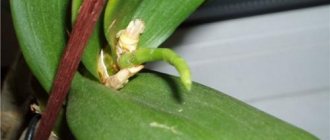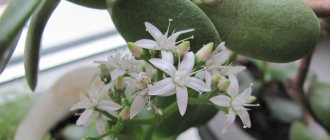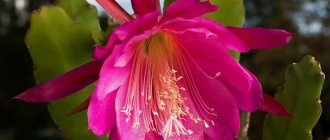Epiphyllum can often be found not only on window sills in private homes, but also in office buildings.
Growing the plant is easy and simple, but the main advantage of the plant is its flowering. Large fragrant inflorescences of white, yellow or red color with all sorts of shades of these colors immediately attract attention. With proper care and suitable conditions, these cacti are capable of laying buds twice a year. At the same time, sometimes their flowering makes itself wait. There may be several reasons why the epiphyllum does not bloom, and in most cases it is not the fault of the forest cactus. He lives in the conditions that were created for him. But the presence or absence of buds will show whether the flower is comfortable or not. So, epiphyllum does not bloom if:
- the pot is not selected correctly;
- there is not enough light;
- the flower has an excess/lack of nutrients;
- anti-aging haircut is not performed;
- the bush is replanted too often;
- the rest period is absent or incorrectly organized.
Epiphyllums are not capable of laying flower buds at a young age. Flowering occurs only in the 3-4th year of the plant’s life.
Indoor Epiphyllum: flower description
The Epiphyllum genus includes about 20 species. These plants belong to the Cactus family, and in nature they lead an epiphytic lifestyle, growing on the branches and trunks of trees in the tropics and subtropics of the American continent, as well as Mexico.
Epiphyllum is sometimes called Phyllocactus or Phyllocereus. A distinctive feature of this plant is its long, fleshy, cascading stems, which, depending on the type of cactus, can be flat, triangular or zigzag. Over time, the base of the stem begins to become woody and covered with brown bark.
For its magnificent flowering, Epiphyllum was dubbed the orchid cactus. This cactus blooms in spring and summer, very profusely, with large fragrant flowers, and under the sepals there are real leaves, which in appearance are more like spines. The buds are funnel-shaped with many petals. They appear at the ends of stems and can bloom at any time of the day. The color of the orchid cactus petals can be white, vanilla yellow, hot pink and scarlet.
In nature, after pollination, large edible fruits are formed in place of the buds, the color of which depends on the color of the bud itself. At home, cactus fruiting can only be achieved through cross-pollination.
Epiphyllum is grown in modern homes as an ampel plant. Its succulent stems can grow several meters and therefore require periodic pruning. At home, the forest cactus can be placed on a windowsill, table, stand or in a hanging pot to fully enjoy the unusual appearance and beauty of the flowering of this plant.
Growing epiphyllum from seeds
Epiphyllum seeds photo
Seed and vegetative (by dividing the bush, stem cuttings) propagation is possible
Propagating phyllocactus from seeds is quite simple. It is necessary to fill the bowls with substrate for succulents, moisten the soil and distribute the seeds over the surface. Cover the crops with film, maintain the air temperature within 20-23º C. Do not forget to ventilate daily for 30 minutes.
Epiphyllum from seeds photo shoots
When shoots appear, remove the film completely. The sprouts will look like small faceted cacti with spines - over time they will become flat and the spines will fall off. Expect flowering in the 4th-5th year.
Types of Epiphyllum with photos
There are several varieties of Epiphyllum that are very popular with flower growers around the world. To this day, more and more new varieties of this plant are appearing, which are distinguished by their incredible decorative qualities.
Epiphyllum oxypetalum, or sour petal
Fleshy green stems, flat with a wavy edge, can grow up to 3 m. The width of succulent shoots reaches 10 cm. As the bush matures, the lower part of the stems becomes woody and acquires a brown color. The flowers are large, white, up to 20 cm long. The corolla, consisting of many narrow petals, opens to 18 cm. Today, based on this species, a large number of hybrids have been obtained, which can boast flowers of the most incredible colors and sizes.
Guatemalan Epiphyllum (Epiphyllum guatemalense)
Within this species, there are 2 varieties: one has stems consisting of many segments, which in appearance are very reminiscent of oak foliage, and the other has solid stems, chaotically twisted into bizarre falling curls. The buds of both varieties are large, colored in different shades of pink.
Epiphyllum thomasianum
In the wild, a cactus can reach truly majestic sizes and grow up to 4 m, but at home it looks somewhat more modest and its fleshy branches hardly exceed 70 cm in length. The flowers are white, large, with a bright yellow center. The diameter of the corolla reaches 25 cm.
Hooker's Epiphyllum (Epiphyllum hookeri), or acute petal
The heavy, dark green, flat stems of this variety bend in an arc under their own weight. In its native places, Cuba, Mexico and Venezuela, this epiphyte can grow to enormous sizes. It blooms with large snow-white flowers with a subtle, subtle aroma.
Serrated epiphyllum (Epiphyllum crenatum)
This species leads a semi-epiphytic lifestyle. Its shoots at room conditions reach 70 cm in length and 10 cm in width. The shoots are fleshy, greenish-blue in color, with many deep cuts along the edge. The flowers are fragrant, up to 15 cm in diameter. Numerous hybrids boast a wide variety of colors.
Epiphyllum phyllanthus
The stems of this species grow up to 1 m, and leaf shoots up to 25-50 cm. The flowers are pink, large, up to 15-18 cm in diameter.
Epiphyllum ackermanii
A plant with drooping thin stems, which at a distance of 40-70 cm from the base begin to form flat branches with many teeth. The flowers are large, fiery red in color, and appear at the ends of the shoots.
Epiphyllum anguliger, or angular
This species is distinguished by good branching of stems and their incredible zigzag shape. The shoots are dark green, round or with three edges, the lower part of which becomes woody, and the upper part remains triangular or flat. The length of the succulent stems reaches 1 m, and their width is 4-8 cm. The flowers are large, deep red, fragrant. The diameter of the corolla reaches 8-10 cm.
Epiphyllum laui
This species grows in nature as an epiphyte or lithophyte. It has a fast growth rate. The stems have thin, hair-like spines up to 4 mm long. The flowers open in the evening and at night. They are large, fragrant, creamy white in color. The flowers last for about 2 days, then fade.
What to do if the plant does not bloom?
Sometimes gardeners have a problem - the epiphyllum does not bloom. Its growth can occur with standard care, but the formation of buds is not observed. How to make a cactus bloom? This requires creating special conditions. It is necessary to create the right conditions in winter, since the quality of this determines flowering in the summer months. To stimulate flowering, you should use the following recommendations:
- At the end of February, when the cactus begins to form buds, it should not be transported or rotated to preserve them;
- In March, intensive watering should be carried out. It is necessary to constantly monitor the level of soil moisture;
- Old shoots need to be cut off, since the epiphyllum spends energy on them that it could spend on flowering;
- The cactus container should be quite tight.
If all care measures are followed, there should be no problems with flowering. This is a capricious plant, and therefore you should carefully monitor it.
Caring for Epiphyllum at home
Epiphyllum, despite its spectacular appearance, is a rather unpretentious plant. By following the simplest rules, you can easily grow this cactus in an ordinary city apartment.
Lighting
To maintain a healthy, decorative appearance and abundant flowering, it is important to provide the plant with bright lighting. Epiphyllum grows well in a sunny place, but it should still be protected from direct sunlight. In the house, the plant is placed on the windowsill of a western or eastern window, or near southern windows, so that the scorching sun does not burn its shoots. Epiphyllum can also grow on a north window, but then it will need additional lighting, otherwise flowering will be poor.
Temperature
In spring and summer, the cactus is kept at a temperature of 20-25 degrees. In the fall, it is recommended to gradually transfer the plant to winter mode, slowly lowering the temperature. From November to February, Epiphyllum is at rest and during this time it will feel comfortable at 10-15 degrees.
Humidity and watering
During the active growing season from spring to the end of summer, the cactus is watered abundantly. Watering is carried out with soft, settled water at room temperature after the top layer of soil has dried. In winter, water sparingly, preventing the substrate from drying out.
The level of humidity in the room does not greatly affect the condition of the plant, but in hot weather in the morning or evening it can be irrigated with fine water mist from a spray bottle. Do not spray the cactus with cold water; it is advisable to use warm, soft water.
Top dressing
Epiphyllum growing at home requires good feeding for good flowering and vigorous growth, so from spring to autumn the soil in the pot is fertilized with special mineral fertilizers for cacti. The frequency of fertilizing is 2 times a month according to the instructions.
The soil
The soil for Epiphyllum is chosen to be light and nutritious. You can use equal parts of turf soil, humus and sand, or buy cactus substrate at a flower shop. It is recommended to mix the purchased soil mixture with peat in equal proportions.
Pot
Stagnation of moisture is detrimental to Epiphyllum, so holes must be made at the bottom of the planting container. You can choose a plastic or ceramic pot, the main thing is that it is stable and slightly larger than the previous one.
Transfer
Epiphyllum is transplanted after flowering has ended. When the last flower fades, the plant is allowed to rest for about 4 weeks and then transplanted into a new pot. The cactus is replanted by handling, trying not to break the fragile stems. Young cacti require annual replanting, while older cacti can be replanted every 2-3 years.
Rest period
Epiphyllums should rest well from the last days of October to February, then next year they will delight with lush flowering. At this time, the cactus is kept in a well-lit, cool place at a temperature of 10-15 degrees. It is advisable to stay at the lower end of the recommended range. Water sparingly during the dormant period so that the roots do not dry out.
At the end of winter, gradually increase the temperature in the room and gradually resume watering.
What is the relationship between pot size, replanting and flowering of a cactus?
It is not for nothing that epiphyllums bloom only in adulthood. The first few years they actively build up the root system. And only when the roots fill the space of the flowerpot does the budding process begin. Therefore, it is important to choose a pot that is wide enough, but not deep, for the cactus.
For the same reason, you should not replant the bush every year, replacing its flowerpot with a more spacious one. In this case, the cactus will again devote all its energy to growing roots and forget about flowering. It is enough to replant young epiphyllums once every 2 years, and adults - every 3-4 years.
Epiphyllum bloom
Once the buds begin to set, the flower should not be disturbed under any circumstances. It is prohibited to rearrange, rotate or move it, otherwise this will lead to all the blooming flowers and buds falling off.
The flowers bloom alternately, and each one retains its freshness for about a week. Some species can delight you with their flowering twice - in spring and autumn.
During flowering, water Epiphyllum abundantly, but do not allow moisture to stagnate in the pot. Also, we must not forget about fertilizing so that the plant does not experience nutrient deficiency. During this period, potassium, phosphorus and calcium are especially important for the flower.
Why doesn't Epiphyllum bloom?
There may be several reasons for the lack of flowering. Epiphyllum usually refuses to bloom due to improper care and non-compliance with maintenance conditions.
Epiphyllum will not bloom if:
- Lack of light;
- Lack of nitrogen;
- Warm wintering;
- Abundant watering during the dormant period.
If you follow the care recommendations, especially in the cold season, then problems with Epiphyllum flowering usually do not arise. It is advisable to eliminate the problem in time, then, perhaps, in a few months the plant will be strewn with beautiful and fragrant flowers.
How to stimulate flowering
Proper care, periodic pruning and cool wintering will help stimulate flowering. Then the plant will bloom brighter and more abundantly.
To stimulate flowering, take the following measures:
- Increase daylight hours and illumination intensity. If the plant is in the shade, then it is necessary to install special lamps for additional illumination. Phytolamps should work approximately 10-12 hours a day.
- Reduce watering. It is necessary to reduce the frequency and reduce the amount of moisture.
- Set the correct temperature. In spring and summer, the flower is kept at 20-25 degrees, and in winter 10-15 degrees.
- Pruning is carried out after hibernation.
- Organize a comfortable winter stay.
Growing and growth conditions
Epiphyllums, like most cacti, are experiencing a period of rapid growth and calm. During the cold season, there is a lull for them, all processes slow down. In spring, flowering and shoot growth begin.
Important conditions for epiphyllum
| Season | Watering | Air temperature, degrees | Fertilizer | Other care |
| Winter | minimum | 10–13 | No | No |
| Spring | abundant | 20–25 | complex compositions for forest cacti | pruning shoots that bloomed last year |
| Summer | abundant, spraying leaves | 22–25 | nitrogen fertilizers, complex compositions | pruning shoots, including triangular ones |
| Autumn | moderate | 15–20 | for problems, complex formulations | replanting after flowering ends |
Lighting in any season should be diffused.
Tradescantia is unpretentious and easy to care for. More details about this plant:
How to prune Epiphyllum
Buds are formed only on old shoots from last year. In addition, Epiphyllum grows quickly and to maintain a neat appearance it will be necessary to carry out systematic pruning. Round or faceted branches should be cut out, as they usually do not bloom, and the length of flat shoots should be adjusted.
When cutting flat shoots, you need to be careful, since it is on such stems that flowers appear. Faded shoots will not produce flowers the next time, but they provide normal vital activity for the entire plant, so they can be pruned no sooner than after a couple of years.
The shoots are shortened only after flowering and before the start of hibernation. Shoots with corky growths are removed without regret, as well as all weak, twisted and damaged branches. After flowering, it is also necessary to remove wilted flowers, and all open and damaged areas are treated with crushed coal powder.
Process description
The buds are formed on the thickenings of the shoots located at the ends of the stems. They begin to open one by one. Each flower bud produces a flower only once during its life, then dies.
The flowers are large, funnel-shaped, with a long corolla tube. They can reach 40 centimeters in length. Their diameter, depending on the variety, ranges from 8 to 25 centimeters. The color of the corollas can be white, cream, yellow, lemon, orange, pink, red. The ovary and tube are covered with hairs or small spines. The flowers have a delicate aroma and open during the day or at night.
In the photo below you can see a blooming epiphyllum.
How to extend it at home?
From the end of February, place the plant in a warm place and increase watering. In spring, stimulate the epiphyllum to awaken with a warm shower. Soon thickenings appear on the shoots, from which flowers develop. In March–April, flower buds are laid and buds are formed.
During this period, you cannot turn the pot with the plant and move it to another place, otherwise the buds will fall off. It is necessary to increase the temperature and increase the frequency of watering. Apply the first fertilizing.
During flowering, water so that the soil in the pot remains slightly moist between treatments. Keep at a temperature not lower than +15°C, optimal values are from +20 to +25°C. Feed once every two weeks with special fertilizers for cacti. You cannot spray. If good conditions are provided, the epiphyllum will bloom again in early autumn.
Epiphyllum propagation methods
At home, Epiphyllum can be propagated by seeds, cuttings or dividing the bush.
Seeds
The succulent is easily propagated by seeds. It is almost impossible to obtain mature seed material at home, so Epiphyllum seeds are usually purchased at the store.
Seeds are sown in a wide bowl on the surface of a moistened soil mixture for cacti. The dishes with seedlings are covered with film and left in a warm place. To obtain friendly shoots, maintain a temperature of 20-23 degrees and ventilate the crops daily for 30-60 minutes. The appearance of the shoots is very similar to ordinary cacti. They are green, faceted, and small spines are visible on the surface.
After the emergence of friendly shoots, the shelter is removed. Over time, the shoots will acquire a flat shape and lose their spines, then they can be carefully planted in separate pots and cared for as adult plants.
Epiphyllums grown from seeds bloom only after 4-5 years.
Dividing the bush
If necessary, a large overgrown bush is divided into several parts. The procedure is carried out during transplantation, after flowering, in the following sequence:
- The plant is removed from the pot and the roots are cleared of the soil.
- The bush is carefully divided into several parts, leaving developed roots and several healthy young shoots in each plot.
- Remove diseased roots and sprinkle cut areas with crushed coal.
- The plots are planted in separate pots.
After planting, the divided Epiphyllum is placed in the shade and occasionally watered with warm water. Watering should be scanty and infrequent, and when the plant begins to show signs of growth, it is placed in a permanent place and watering is gradually increased to normal.
By cuttings
Epiphyllum is propagated by stem cuttings in the spring in April-May. You can use parts of branches 10-13 cm long.
Cuttings are carried out as follows:
- A part of a flat shoot 10-13 cm long is cut off from the mother bush.
- The lower cut is made wedge-shaped.
- The cuttings are placed in a glass for 2 days to allow the juice to drain.
- The cut part of the shoot is rooted in a moist soil mixture consisting of one part perlite and three parts cactus substrate. Cuttings are planted to a depth of 1 cm.
- After planting the seedling, the surface of the substrate is sprinkled with fine sand, forming a layer of 2 cm.
At first, the seedlings are kept in the shade, and the first watering is carried out only 2 days after the planting procedure.
Phyllocactus fruits
Epiphyllum can bear fruit even at home. This requires artificial cross-pollination. The fruits are often covered with spines and are similar in shape and size to plums. Their color depends on the shade of the flowers.
There are yellow-green or purple fruits. You can eat them. The pulp has a pleasant sweetish taste, reminiscent of a mixture of pineapple and strawberries. The fruits are eaten separately, like fruits or berries, and are also added to various dishes. Pre-cleaned from thorns. The fruits are used in folk medicine. Infusions, ointments and compresses are prepared from the pulp.
These remedies help in the treatment of headaches, colds, diseases of the cardiovascular, genitourinary and nervous systems, gastrointestinal tract, skin and joint diseases. The fruits are especially widely used in the fight against psoriasis.
Diseases and pests
When growing Epiphyllum, gardeners may encounter some problems. With proper care, this plant is rarely affected by diseases and pests, but it is still important to recognize the disease in time and take action.
Diseases
Epiphyllum can suffer from rust, fusarium, anthracnose and black rot.
Rust appears as untidy red spots. It can appear from waterlogging of the substrate, moisture on the surface of the stem and sunburn. If signs of the disease are detected, they are treated with fungicides and the conditions of detention are carefully regulated.
Black rot appears as characteristic spots on the surface of the stems. Damaged areas must be removed, the cut areas must be sprinkled with coal and the entire plant must be treated with fungicidal preparations.
Light brown dead areas indicate the development of anthracnose. Then all diseased branches are removed and treated with fungicides.
Fusarium appears from constant waterlogging. At the same time, the stems turn red and the root system begins to rot. You should remove the plant from the pot, clean the roots from the soil, rinse them with water and remove the damaged parts. The cut areas are treated with charcoal and treated with fungicides.
Pests
Particularly dangerous for Epiphyllum are spider mites, aphids, mealybugs and scale insects.
If the air in the room is too dry, spider mites may appear. The problem can be solved with the help of insecticides and treatment with a soap solution. A good preventative measure would be spraying and humidifying the air in the room.
If aphids and mealybugs are detected, they are also treated with insecticides, for example, Actellik, Fitoverm or Aktara.
When small brown growths appear on the stems, this indicates the appearance of scale insects. They are removed mechanically, and the plant is sprayed with pest control agents.
Dividing the bush
Divide the bush when transplanting an adult plant. Remove the phyllocactus from the pot, divide it into parts so that each section contains healthy, young stems and strong roots. Cut off dry, rotten areas and treat with fungicide. Plant in separate pots with drainage and substrate suitable for growing epiphyllum. Adaptation requires partial shade and minimal watering.
Possible difficulties
If the content is incorrect, the following problems may occur:
- Pale and wrinkled stems - poor watering, high temperature and stale air in the room.
- Dry yellowish spots on the shoots are sunburn.
- Soft stems – a common cause is root rot, which can be a result of overwatering and poor drainage.
- The falling of buds, the tips of the branches drying out, and the appearance of a light pattern on the stems are symptoms of a viral mosaic. The infected plant is quarantined, all affected areas are removed and treated with special preparations.
- The stems become woody and the bush loses its decorative effect - pruning is required.
Epiphyllum is a beautiful and unpretentious plant that blooms every year with a large number of huge flowers. For its unusual, exotic appearance and unpretentiousness to living conditions, this plant is so loved by flower growers around the world. If you provide the flower with favorable conditions, a sufficient amount of light, heat and periodic pruning, you can easily grow a piece of the tropical forest at home.
Why doesn’t the plant produce buds, and how can I make it bloom?
- lack of light;
- watering errors;
- incorrect temperature and air humidity;
- inadequate feeding;
- lack of fresh air;
- untimely transfers;
- pot too spacious;
- untimely removal of old shoots;
- no rest period.
To cause flowering, you need to create special conditions:
Lots of light. Choose a place for the epiphyllum on the windowsill of an east or west window. If only the northern direction is available, place the plant near the glass. In such conditions, flowering can be achieved, but it will not be lush. On the southern windowsill, the epiphyllum is slightly shaded with gauze or a tulle curtain. Open sun is harmful to the plant.- Correct watering regime. In winter, during the rest period, moisten the soil rarely and with small portions of water. In a cool room, one watering per month is enough, in a warm room - twice. If the epiphyllum bloomed in the fall, do not stop watering. Hibernation lasts three months. In February - March, increase the frequency of watering. The soil should not be allowed to dry out, otherwise the above-ground part of the cactus will begin to die. Use settled water at room temperature.
- Correct temperature conditions. In summer, indicators should be in the range from +20 to +25°C. In autumn you can keep epiphyllum on a balcony or loggia. When the night temperature drops to +5°C, move it to the room. A successful wintering takes place at temperatures from +12 to +15°C.
- Fresh air. In summer, epiphyllum feels more comfortable on the balcony or on the street than indoors.
- Timely removal of old shoots. Pruning is done in the spring, before the start of the growing season. Such events are held every two to three years. Old shoots do not bloom and must be removed to stimulate the growth of new stems. Sometimes thin shoots grow. Flowers are not planted on them; it is better to cut them so that the plant does not waste its energy. Leaves strong, wide stems.
- Timely transplant. It is not recommended to replant the plant frequently. After each change of pot, active development of the root system begins, which prevents the growth of stems and the formation of flower buds. Young specimens are replanted every two years, adults – every three or four years. The event is held in late spring or early summer, after the end of the flowering period. They use the transshipment method to avoid damaging the roots.
- Complete nutrition. In the spring-summer period, fertilizers are applied to cacti once every two weeks. In winter, fertilizing is not needed.
- A pot of the appropriate size. Epiphyllum blooms when the roots become cramped in the container. A shallow pot is suitable. When replanting, take a new pot two to three centimeters wider than the previous one.
- Rest period. Provide a cool winter with limited soil moisture.
Epiphyllum blooms only when properly maintained. During the dormant period, coolness and a minimum of humidity are required. During the formation of buds, the epiphyllum should not be disturbed.
After flowering, air baths in the fresh air and spraying are useful. If you follow all the recommendations, an adult epiphyllum will definitely delight its owner with magnificent flowers.
If you find an error, please select a piece of text and press Ctrl+Enter.
Beneficial and medicinal properties of Epiphyllum
The plant itself, its juice and fruits have valuable qualities:
- Some believe that the cactus protects against electromagnetic radiation;
- Phyllocactus juice is a diuretic - useful for edema;
- Cactus juice is used for cardiovascular, gastrointestinal and neurological diseases;
- The juice and fruits of the plant help with rheumatic pain;
- Cactus juice alleviates the condition of patients with psoriasis;
- Epiphyllum is used in the food industry for the preparation of candied fruits, drinks and desserts. Gourmets eat cactus raw and fried;
- Used for decorating rooms.
Leaves, flowers and fruits of epiphyllum
A cactus called epiphyllum is a beautiful flowering plant with large leaf-like shoots. The stems are long, wide, belt-shaped or triangular, with a pronounced central vein, without thorns, fleshy, with jagged edges. The leaves are formed as small scales and are located in the recesses under the areoles.
Blooms in spring and summer. The flowers are fragrant, large, very beautiful, with satin petals, come in all colors of the rainbow, the flower tube is long. For these unsurpassed characteristics, the plant is popularly called the “orchid cactus.”
With artificial cross-pollination, the epiphyllum produces fruits. They are quite large - like a plum. The outer surface is yellowish-green or purple (this is influenced by the color of the flowers), and is often covered with needles. The fruits are distinguished by edible pulp - juicy, aromatic, sweetish, slightly reminiscent in taste of a mixture of pineapple and strawberries. Inside there are a small number of black seeds, the length of which reaches about 2 mm.
How the fruits produced by the epiphyllum flower look from the outside and in cross-section, look at the photos below:
Signs and superstitions
All the signs that people associate with cacti fully apply to Epiphyllum, and whether to believe these signs or not is up to each person:
- A blooming cactus promises an addition to the family, and promises the lonely a meeting with their betrothed;
- You cannot give a cactus to a loved one - it promises separation;
- For unmarried women, the cactus drives away suitors;
- The cactus protects the house from all sorts of troubles.
The huge variety of species and varieties of Epiphyllum, its relatively easy nature in terms of maintenance and care, and the splendor of flowering plants attract more and more gardeners to breeding this particular genus of cacti. And for its medicinal properties it deserves special respect and love.
Sources
- https://rastenievod.com/epifillum.html
- https://www.flowerbank.ru/?p=10473
- https://komnatnie-rastenija.ru/jepifillum-uhod-v-domashnih-uslovijah-foto-vidov-razmnozhenie/
- https://kvetok.ru/komnatnye-rasteniya/jepifillum-populjarnye-raznovidnosti-uslovija-vyrashhivanija
- https://stroy-podskazka.ru/epifillum/vidy/
- https://dcactus.ru/epifillum/
- https://ProZvety.ru/katalog-rastenij/kaktusy/ehpifillum-s-foto
- https://dacha.help/cvety/epifillum-samyiy-effektnyiy-lesnoy-kaktus-udostoennyiy-zvaniya-orhidei
- https://MrDachnik.com/epifillum
[collapse]
Spotted stems and other problems
Table: correcting care errors and saving and treating diseases
| Problem | Cause | Elimination |
| Epiphyllum stems wither | Root rotting due to waterlogging of the soil: most likely, the cactus was flooded | Reduce watering, replant the plant, removing rotten roots |
| The buds appeared but fell off | Moving the plant or excessively bright light | Do not disturb the plant, if it was not possible to achieve flowering, remove the aged stems by the next season, they are triangular in shape |
| The tips of the shoots dry out, and the stems are covered with ring-shaped spots, similar to cork wood | Fungal or viral infection | The plant cannot be treated. To prevent the infection from spreading, the flower is destroyed |
Epiphyllums do not suffer much from pests. But this flower still has enemies. Therefore, inspect the plant more often to identify pests and begin to fight them in a timely manner.
Table: how to save a forest cactus from pests
| Pest | Sign | Way to fight |
| Spider mite | Cobwebs on stems |
|
| Aphid | Insects are visible on the flower | Purchase aphid repellent from a specialty store and follow the instructions. |
| Mealybug | Cotton-like coating on stems |
|
| Shchitovka | Brown plaques on stems |
|
| Slugs | Insects leave behind silvery trails of dried mucus | Place granules of Thunder or Meta preparations under the plants. |
Emerging problems
Diseases
Diseases affecting Epiphyllum are:
- Rust occurs from waterlogging of the soil during cooling, from the accumulation of moisture on the stem, or from burns by the rays of the sun. It looks like untidy spots of a rusty hue. Treatment with a fungicide and regulation of care conditions is necessary.
- Black rot affects the stems - spots with a black sheen. Control - removal of affected areas and chemical treatment.
- Anthracnose is a light brown spot. It is necessary to cut out diseased stems and spray with fungicide.
- Fusarium rotting of roots from chronic waterlogging and redness of stems. You should remove diseased roots, replant the plant and monitor watering.
Pests
Among the pests that are especially dangerous for Phyllocactus are:
- Spider mites - they suck nutritious juices from the plant and appear in fairly dry conditions. Control measures include increasing humidity and treating with acaricide.
- Aphids - by sucking cell sap, disrupt the development process of the cactus, and in addition, they are a carrier of viruses. Insecticide treatment required.
- Mealybugs slow down the growth of the cactus by sucking out nutritious juices and leaving a waxy coating. The plant is infected with viral diseases. To eliminate the pest, you need to wipe the cactus with alcohol or a detergent solution. If necessary, apply chemical treatment.
- Scale insects harm the development of the plant. Control measures include inspecting the stems and removing bugs. As a last resort - chemical treatment.
Temperature and lighting
During active growth and development, the plant will be comfortable at normal room temperature. When vegetative rest begins, the temperature should be reduced to +10 degrees. In extreme heat, the plant will be able to develop well, but it is necessary to increase watering and increase air humidity. During the spring-summer period, the best temperature is considered to be +20- +25 degrees.
There are also species that are able to withstand temperatures dropping to below 0, but such risky conditions should not be created for them.
Reducing the temperature to + 10 in winter will promote better and more abundant flowering and will prevent the cactus from stretching too much, which is important during periods when there is not enough sunlight. This way the plant will maintain its healthy appearance and shape.
The cactus loves bright lighting, so it must be placed in an appropriate place. Epiphyllum growing indoors will be comfortable under the sun's rays in the morning and evening, but during the spring-summer period, during the daytime, it must be covered from the sun. Fluorescent lamps can be used to increase illumination. If the plant lacks light, it will bloom sparingly or not at all, and the cactus will become overly elongated.
By placing the plant on the southwest side or southeast side of the window, the plant will always receive the right amount of light. The south side is also suitable, but in the daytime the plant will need to be shaded using tulle. If it is possible to grow a plant only on the north side, then it is necessary to create artificial lighting. In order for the cactus to grow evenly, it must be periodically turned in different directions towards the light source. This should not be done during the period of budding and flowering.
Epiphyllum is not a demanding plant when it comes to humidity levels, but if the air is too dry at high temperatures, spraying should be done using soft and warm water. When spraying plants, do not allow water to get on the buds and flowers. These activities can be carried out before noon, so that by the evening all the moisture has time to evaporate.
To increase humidity, you can use humidifiers and place a jar of water near the cactus. Wet pebbles placed on a tray under the pot and placing other plants near the epiphyllum will help maintain a good level of humidity. Using a decorative fountain will not only increase the humidity level, but will also provide additional decoration. During the autumn-winter period, there is no need to humidify the air, especially if the room temperature is reduced.











